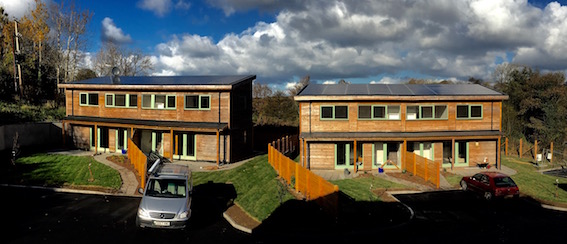
The two bedroom Ty Solar properties (pictured) boast 6.5kW arrays to provide energy to tenants and excess power to be exported and provide an income from the landlord. Image: Western Power.
A cluster of eco homes utilising solar panels are being used to provide low cost public housing to tenants in Pembrokeshire as part of Wales’ first solar village.
Four of the six new homes built by Western Solar at the Pentre Solar development in Glanrhyd are being offered to tenants on Pembrokeshire County Council’s social housing waiting list. Each is equipped with a large solar installation on the properties’ monopitch roofs to provide low cost energy for the occupant.
Meanwhile, Western Solar receives an income from the export of solar energy to the grid as the systems – 6.5kW on each of the four semi-detached homes and 13.5kW on the two detached properties – are purposely designed to generate up to three times more than needed by the Ty Solar homes.
This is due to the low energy demand of the eco homes, which are prefabricated from locally sourced timber and use recycled newspaper for insulation to consume just 12% of the energy used in a traditional home.
Western Solar estimates the generation capacities of the solar arrays will produce over £2,000 per annum of cash benefit for each property, or £40,000 over 20 years in terms of energy exported, free energy used in the home and feed-in tariffs.
Combined with keeping two of the properties on the open market, this income from the solar panels allows Western Solar to offer the majority of the homes as affordable housing.
Speaking to Solar Power Portal yesterday following the official opening of the Pentre Solar development, Glen Peters, chief executive of Western Solar, explained: “Essentially our primary business model is targeted at the affordable social housing sector with some mixed housing which helps us cover some of our losses we would make on the social rental…together with the export.”
Originally, the feed-in tariff was intended to play a significant role in the financial case for the solar homes however following cuts enacted early last year Western Solar is now being forced to consider alternate strategies.
“Going forward we won’t be able to benefit in the same way and will have to find other ways. In the next generation we're looking at getting slightly bigger panels – perhaps 300W – so we export more and then perhaps join a community energy scheme so we can claw back some of the very low tariffs we get when we export,” Peters explained.
The company will also seek to pursue partnerships with financiers and other local authorities following the Pentre Solar project in Pembrokeshire due to the high cost of land and the high number of potential tenants around the country awaiting social housing.
The goal is to build 1,000 more houses across the UK over the next ten years.
According to Andrew Davies Wrigley, housing manager at Pembrokeshire County Council, the project fit well with the council’s aims for social housing tenants, and could do the same for other local authorities.
“Something that we're looking at with our own stock is how we can support people with energy bills. Certainly from our point of view we're very interested in any kind of developments that have a different approach and can support people to live more affordably,” he said.
The benefits of the scheme have attracted political support from Lesley Griffiths, cabinet secretary for environment and rural affairs at the Welsh Assembly, who opened the scheme yesterday (5 January).
Great visit to Pentre Solar today – a new and innovative housing development which embodies the WFG goals pic.twitter.com/2N0BkFvxjE
— Lesley Griffiths (@wgcs_enviro) 5 January 2017
“I am delighted to officially open this innovative housing development, which is not only providing much needed housing for local people, it is also addressing many other key issues such as energy efficiency, fuel poverty, skills development and the use of Welsh timber,” she said.
“I am sure the tenants will be very happy in their new homes and with their lower bills.”
Western Solar will now select tenants from the housing register, with successful applicants required to show an interest and understanding of sustainability and energy management. It is expected that they will move in to the properties by the end of the month.

